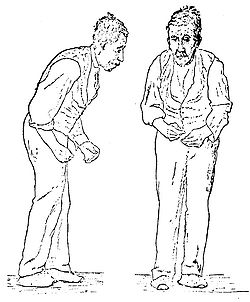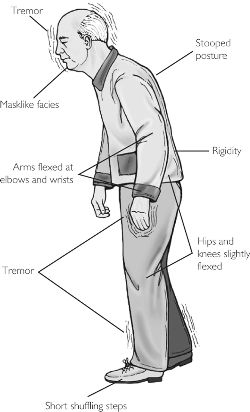Parkinson’s disease is a progressive, neurodegenerative disease that occurs when the neurons within the brain responsible for producing the chemical dopamine become impaired or die. This disease progresses very slowly and most people who are ever diagnosed with it have been living with it for at least 20 years before severe symptoms start to show. PD can cause the neurons in the brain that produce dopamine to concentrate together on a particular area that we call Subsantia Nigra in the brain. The chemical dopamine relays messages between the Substantia Nigra and the rest of the body.
- First discovered by English doctor, James Parkinson in 1817

- Affects 1 in 100 people over the age of 60
- People as young as 30 have also been affected
- Central nervous system disorder that results from death of cells in movement-control part of brain. Cell death can be a result of infection, trauma, poisoning, certain drugs, environmental toxins
- Causes a progressive decrease in ability to move and control the speed and smoothness of this motion
- Symptoms: shaking of hands, slow movement when walking or eating, muscle stiffness, imbalance, little facial expressions and not much eye blinking, handwriting changes (letters get smaller and smaller across the page). Symptoms appear gradually and worsen over time
Mode of Inheritance
- Some research has suggested that it is an autosomal dominant trait which means that a parent with PD has a 50% chance of giving it to their child, however, this is not a common occurrence
- Also said to be a multifactorial disorder as it maybe be linked to environmental neurotoxins like pesticides
Clinical Description
- Slow or uncontrolled movement

- Shaky hands
- Imbalance
- Muscle stiffness
- Speech problems
- Features appear gradually and worsen over time
- Known as a “boutique” disease meaning that what symptoms you get and how they worsen is only known to your body
- Not fatal itself, but the symptoms that occur like the slow movement and imbalance can cause falls that can be fatal
The four main symptoms of PD are shaking or tremor at rest, slowness of movement called Bradykinesia, Stiffness and ridgity of the arms legs or trunk and trouble with balance called postular instability. Other symptoms may include Fatigue, cognitive impairment, depression, sleep disturbances, speech problems, Gastrointestional issues , pain, Orthostatic hypertension (or low blood pressure), skin changes, and vision changes.
There are ten common early signs of PD. They are: tremor or shaking of one’s body continuously, small hand writing, loss of smell, trouble sleeping, trouble moving or walking, constipation frequently, soft or lowered voice, masked face, dizziness or fainting, stooping or hunching over at random times especially after strenuous activity. Other symptoms patients may have is fatigue, cognitive impairment, depression, sleep disturbances, speech problems , Gastro intestinal issues , pain, low blood pressure, skin changes, and vision changes.
Clinical Rating
There are several rating systems in place to stage Parkinson’s disease. A widely used scale developed by Hoehn and Yahr categorizes people with the disease into one of five stages. These stages can help healthcare providers decide what treatment to recommend. They can also help families gain a better understanding of how Parkinson’s disease progresses. The overall effect and severity of Parkinson’s disease symptoms increases with each of these stages.

My father has suffered from Parkinson’s disease.
What should I do and which precautions need to take.